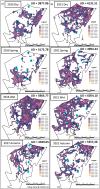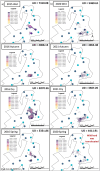Movement patterns of two reintegrated African elephant (Loxodonta africana) herds: transitioning from captivity to free-living
- PMID: 38854797
- PMCID: PMC11162612
- DOI: 10.7717/peerj.17535
Movement patterns of two reintegrated African elephant (Loxodonta africana) herds: transitioning from captivity to free-living
Abstract
With the escalating challenges in captive elephant management, the study of elephant reintegration emerges as a pivotal area of research, primarily addressing the enhancement of animal welfare. The term 'reintegration' refers to the process of rehabilitating captive elephants to a natural system, allowing them to roam freely without intensive human intervention. There is a relative paucity of research addressing the behavioural adaptations post-reintegration, despite reintegration of over 20 elephants across various fenced reserves in South Africa. Our study centres on two distinct herds of reintegrated African elephants, monitoring their movement patterns in two South African reserves over a 57-month period post-release. The primary goal of the study was to establish whether the flexibility and adaptability of movement behaviour of reintegrated elephants can be considered as one of the indicators of determining the success of such an operation. The second aim of our study was to investigate if the reintegrated elephants demonstrated an adaptability to their environment through their hourly, daily, and seasonal ranging patterns after a period of free roaming that exceeded 4 years. Our findings indicated that reintegrated elephants, much like their wild counterparts (movement based on literature), displayed notable seasonal and diurnal variations in key movement parameters, such as utilisation distribution areas and reserve utilization. These patterns changed over time, reflecting an adaptive shift in movement patterns after several years of free roaming. Notably, the trajectory of changes in movement parameters varied between herds, indicating unique adaptation responses, likely resulting from differences in the reintegration process (familiarity of reserve, season of release, presence of wild elephants). Although our study is constrained by the limited number of reintegrated herds available for analysis, it underscores the potential of captive elephants to successfully adapt to a free-living environment, emphasising the promising implications of reintegration initiatives.
Keywords: African elephant; Captive elephants; Movement patterns; Reintegration; Welfare.
© 2024 Roos et al.
Conflict of interest statement
Audrey Delsink is the Wildlife Director of the Humane Society International-Africa. Hanno Kilian is the Ecologist at !Khamab Kalahari Reserve. Andrew Purdon is employed by M.A.P Scientific Services.
Figures










Similar articles
-
Developing welfare parameters for African elephants (Loxodonta africana) in fenced reserves in South Africa.PLoS One. 2022 Mar 24;17(3):e0264931. doi: 10.1371/journal.pone.0264931. eCollection 2022. PLoS One. 2022. PMID: 35324916 Free PMC article.
-
Identifying potential measures of stress and disturbance during a captive to wild African elephant reintegration.PLoS One. 2023 Oct 3;18(10):e0291293. doi: 10.1371/journal.pone.0291293. eCollection 2023. PLoS One. 2023. PMID: 37788241 Free PMC article.
-
Tuberculosis serosurveillance and management practices of captive African elephants (Loxodonta africana) in the Kavango-Zambezi Transfrontier Conservation Area.Transbound Emerg Dis. 2018 Apr;65(2):e344-e354. doi: 10.1111/tbed.12764. Epub 2017 Nov 16. Transbound Emerg Dis. 2018. PMID: 29143466
-
Update on Comparative Biology of Elephants: Factors Affecting Reproduction, Health and Welfare.Adv Exp Med Biol. 2019;1200:243-273. doi: 10.1007/978-3-030-23633-5_9. Adv Exp Med Biol. 2019. PMID: 31471800 Review.
-
Do elephants really never forget? What we know about elephant memory and a call for further investigation.Learn Behav. 2025 Mar;53(1):44-64. doi: 10.3758/s13420-024-00655-y. Epub 2024 Oct 22. Learn Behav. 2025. PMID: 39438402 Review.
References
-
- Angkavanish T, Thitaram C. Behavioral study and monitoring of Asian elephant (Elephas maximus) reintroduction under the Queen’s initiative. In: Aranovich M, Dufresne O, editors. Elephants: Ecology, Behavior and Conservation. New York: Nova Science Publishers, inc; 2012. pp. 133–144.
-
- Ashraf NVK, Barman R, Mainkar K, Choudhury B. The principles for rehabilitation of large mammals (Asian elephant, Asiatic wild buffalo, Asiatic black bear and greater one-horned rhinoceros) In: Menon V, Ashraf NVK, Panda P, Mainkar K, editors. Back to the Wild: Studies in Wildlife Rehabilitation. New Delhi: Wildlife Trust of India; 2005. pp. 91–103.
-
- Baker L, Winkler R. Asian elephant rescue, rehabilitation and rewilding. Animal Sentience. 2020;5(28):296. doi: 10.51291/2377-7478.1506. - DOI
MeSH terms
LinkOut - more resources
Full Text Sources

